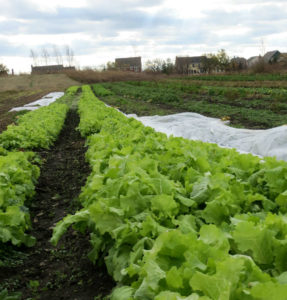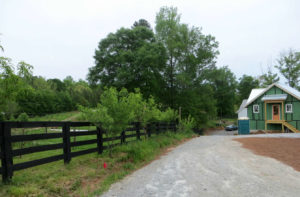Local produce heaven is now… asparagus, strawberries, cherries, snap peas; followed by string beans, cucumbers, basil, tomatoes, peaches; culminating with apples, corn, winter squash. What would make every food summer more perfect? Living in a community that grows, savors, entertains, and surrounds itself with good food. A weekly trip to a local farmers’ market or attempting to grow my favorite foods on a city lot are just not enough.
Our country began as an agrarian society, but with industrialization, rural towns lost population and families moved away from living adjacent to where their sustenance grew. Larger farms and companies, such as Dole, Kellogg, and Kraft now grow, store, process and supply most of the food we eat. King County residents eat $6 billion of food every year with only 2% or $120 million of agricultural products grown in county. Non-profits, governments, farmers, and consumers are working to strengthen the food system so a greater percentage of our food economy is local. Purchasing and consuming local products taste better because the food has traveled fewer miles and is therefore fresher. Keeping food production local, adds jobs. Rural landscapes stay bucolic rather than being punctuated with houses and strip malls. Much work needs to be done to re-integrate food production into people’s lives, to strengthen the local food market, and to increase market share of regionally grown products. What is another option to re-connect people with their food?
A New Community Development Solution
A new type of neighborhood is cropping up in the United States that includes food production, as a facet or even a centerpiece of a development project. There are foodies that want to live adjacent to where their sustenance is grown and are willing to pay a premium to live in these new projects. Good design is a necessity to minimize the inconveniences of odors, noises, and other activities of life adjacent to a farm. Except for Skokomish Farms with 40-acre lot sizes located 33 miles northwest of Olympia, Washington in a rural area of the state, an agricultural-residential project has not been built in Washington. The Puget Sound region is ripe to create a development that integrates farming with intergenerational living, attention to the natural environment, and green homes with good value.
Why is this type of development model needed? With a 2.8% growth rate over a one-year period ending July 1, 2013 (3), Seattle is the fastest growing big city in the nation adding 18,000 new residents and 15,000 new jobs. At the same time apartment buildings and micro-unit apartment structures, also known as apodments, have sprouted throughout the city creating dense neighborhoods and a true in-city living experience. Not only did Seattle grow, but concurrently the rest of the Puget Sound region increased by more than 44,000 new people. Combined the entire region grew by 62,000 people or the equivalent of the city of Marysville located in Snohomish County. King, Snohomish, and Thurston counties had growth rates of more than 1% during the same time. Noticeably, 30% of the new Puget Sound residents moved into Seattle, while the remainder moved elsewhere in the region. This suggests there is demand and desire to still live in less-dense communities, where housing is more affordable or perhaps to just be outside an urban environment. With surging population, undeveloped land is under pressure for conversion to its “highest and best use” in appraised value, which is development.

Lettuce Growing in November at Sandhill Family Farms at Prairie Crossing
Simultaneously, the US Department of Agriculture’s 2012 quinquennial agricultural survey was released, documenting trends in the local farm economy. Surprisingly and perhaps worrisome is the shrinking average and median farm size over the last 15 years. Kitsap County’s average farm size dropped 74% from a high of 53 acres in 1997 to 14 acres by 2012, while the median farm size dropped during the same period from 11 acres to 6 acres.(4) Skagit County has made significant strides, by increasing the number of farms by 50%, but even so, average individual farm acreage dropped 24% to 99 acres and median farm size fell 53% to 20 acres in the same 15 year period. Almost all the Puget Sound counties now have median farm acreage of 10 acres or less, except Whatcom at 16 acres and Skagit at 20 acres. During the recent recession, all of the counties analyzed saw median farm size drop. The historical decline in total farmland actually slowed in the last 5 years, but there was still a net loss in farmed acreage, too.
Nonetheless with increasing population and decreasing farm sizes, farmland is still highly threatened, so perhaps now is the time to test a new model that re-integrates food production into people’s lives and protects some farmland in perpetuity.
The agricultural-residential development is a solution for an under-utilized property, such as an old golf course, a former farm in an incorporated city, or fertile ground in an urban-growth area that is destined for development. Obviously, the governing jurisdiction would need development codes that allow farming in a residential project.
Homes, cottages, townhouses, perhaps some commercial development could be built adjacent to a farm that is protected in perpetuity. The farm needs to be large enough to be commercially viable and support a livable income. The farmer would run a business that would sell to both the residents but also outside customers. A symbiotic relationship between grower and eaters would ensue.

Unfinished Home Adjacent to Serenbe Farms, Georgia
What else should this type of project include? What should be the minimum farm acreage? What protections should be incorporated into a homeowners agreements to ensure that a farmer can do his/her job without nuisance complaints from neighbors? What should the buffers be between the farm ground and residential units? Should the project include a restaurant featuring the farm’s products? Should there be any restrictions on what should be farmed? Animals? Produce? Organic vs. non-organic? What other amenities are important? What other questions need to be asked?
Across the country agricultural-residential communities are sprouting including Sandhill Family Farms at Prairie Crossing and Serenbe Farms. Each has its own characteristics and community. By living in an agricultural community, the pulse of the growing season will resonate throughout the lives of the families that call the farm home.
Kathryn Gardow, P.E., is a local food advocate, land use expert and owner of Gardow Consulting, an organization dedicated to providing multidisciplinary solutions to building sustainable communities. Kathryn has expertise in project management, planning, and civil engineering, with an emphasis on creating communities that include food production. Kathryn is a Washington Sustainable Food and Farming Network board member. Kathryn’s blog muses on ways to create a more sustainable world.
Notes:
1)1997 Population Data Used: Table CO-EST 2001-12-53-Time Series of Washington Intercensal Population Estimates by County: April 1, 1990 to April 1, 2000, Source: Population Division, U.S. Census Bureau, Release Date: April 17, 2002.
2) 2002 & 2007 Population Data Used: Table 1: Annual Estimates of the Population for Counties of Washington: April 1, 2000 to July 1, 2007 (CO-EST2007-01-53), Source: Population Division, U.S. Census Bureau, Release Date: March 20, 2008.
3) 2012 & 2013 Population Data Used: Estimates of Resident Population Change and Rankings: July 1, 2012 to July 1, 2013, Source: U.S. Census Bureau, Population Division, Release Date: March 2014.
3) 1997, 2002, 2007, 2012 Agricultural Data: US Department of Agriculture Census of Agriculture, Table 1: County Summary Highlights for 1997, 2002, 2007, & 2012 respectively.

